70% of Americans Feel Digital Guilt Yet Keep Scrolling and Streaming, New Airedale by Modine™ Survey Finds
New Airedale Digital Guilt Index shows that while Americans care about the tech’s environmental impact, digital habits lead and guilt takes a back seat.
Americans care about the environmental impact of technology, yet day-to-day digital life keeps accelerating. Streaming, AI tools, and always-on apps have become default habits. The conversation is no longer about whether people will use these services, but how their use coexists with growing concern about the footprint behind them.
This debate lands as AI and high-definition media drive heavier workloads into data centers and the cloud, making the environmental cost more consequential and largely invisible in the user experience. That invisibility fuels the tension at the heart of digital guilt: concern about impact on one side, frictionless convenience on the other. Most people keep scrolling and streaming even when they say the environment matters, which is why guilt often takes a back seat.
To understand what’s really happening in that gap, the data center cooling leader Airedale by Modine partnered with Pollfish to conduct a nationwide survey of 1,000 U.S. adults. The Airedale 2025 Digital Guilt Index evaluated how Americans perceive the environmental impact of their digital lives, where they assign responsibility, and what would actually change behavior. The study also explored which product signals—labels, warnings and transparency about the data-center infrastructure—build credibility and help turn concern into action without asking users to log off.
The research points to a clear pattern: Americans care about the environment and the footprint behind streaming, AI, and the cloud. Many feel guilty about adding to that impact, yet habits win. Because the infrastructure cost is mostly invisible and often underestimated, broad sustainability claims fall flat. Trust shifts to what people can see and use. That means proof in the product, clear signals that the infrastructure runs cleaner, transparent sourcing, and simple cues that make lower impact choices the default.
Key Findings
- Americans score just 36/100 on the Digital Guilt Index, showing guilt is real but weak.
- 78% say they care about the environment, yet concern rarely drives change.
- 70% admit they feel guilty yet keep going, and 69% say their guilt hasn’t shifted in the past year.
- 75% try not to think about the hidden impacts of streaming, gaming, and AI use, keeping guilt in the background.
- 58% underestimate the footprint, rating an hour of streaming as “low impact.”
- 50% have never considered their own digital footprint, underscoring shallow awareness.
- 62% place the burden on data centers, not personal devices, transferring responsibility upstream.
- 56% have never lowered video quality to save energy, showing voluntary trade-offs are rare.
- Design nudges can shift behavior: 67% say they’d cut back if shown a red carbon warning, and 59% are open to friction like pop-ups or slower loads.
- Credibility is fragile: 35% don’t trust “carbon-neutral” claims, but 63% want companies to advertise eco-friendly data centers, and 68% assign responsibility to tech companies or “all equally.”
Digital guilt is measurable and it sticks
Americans scored just 36 out of 100 (on a scale of 1 – 100) on Airedale’s Digital Guilt Index, a new benchmark for how conflicted people feel about the environmental cost of their online lives. That low score shows guilt exists but sits in the background—acknowledged, yet rarely decisive in daily behavior.
The survey illustrates this contradiction. 70% admit they feel guilty yet keep going, and 69% say their guilt hasn’t shifted in the past year. Meanwhile, 75% try not to think about the hidden impacts of streaming, gaming, and AI use. Guilt lingers as an undercurrent, but it doesn’t break through the convenience of digital habits.
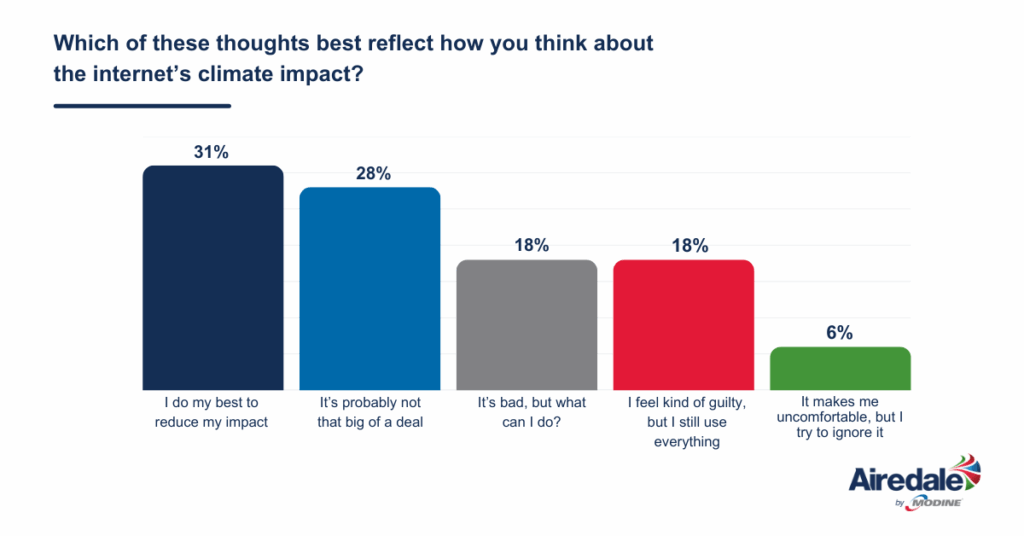
Taken together, the findings suggest that digital guilt functions less as a driver of action and more as a background condition. People recognize the issue, but the discomfort is thin—enough to register emotionally, not enough to reshape behavior. The Digital Guilt Index quantifies that gap, turning a vague feeling into a measurable signal of the tension between concern and convenience.
Digital life is heavier than it looks
Most people struggle to picture what their digital life “weighs.” The infrastructure behind streaming, AI and the cloud is out of sight, and the units of impact are abstract. As a result, the footprint often feels distant, hard to size and easy to set aside in the moment.
58% rate a one-hour streamed episode as low impact. 50% say they’ve never really considered their own digital footprint. And when people do assign impacts, 62% place most of the burden upstream in data centers rather than on personal devices. In reality, estimates of streaming’s footprint have swung from exaggerated headlines to newer analyses showing a smaller but still measurable cost — roughly 36 g CO₂ per hour, according to the IEA. That uncertainty reinforces complacency. And across a year, internet use still adds up to about 229 kg CO₂, roughly the same as driving 500 miles in a typical vehicle (400 gallons per mile, per EPA estimates).
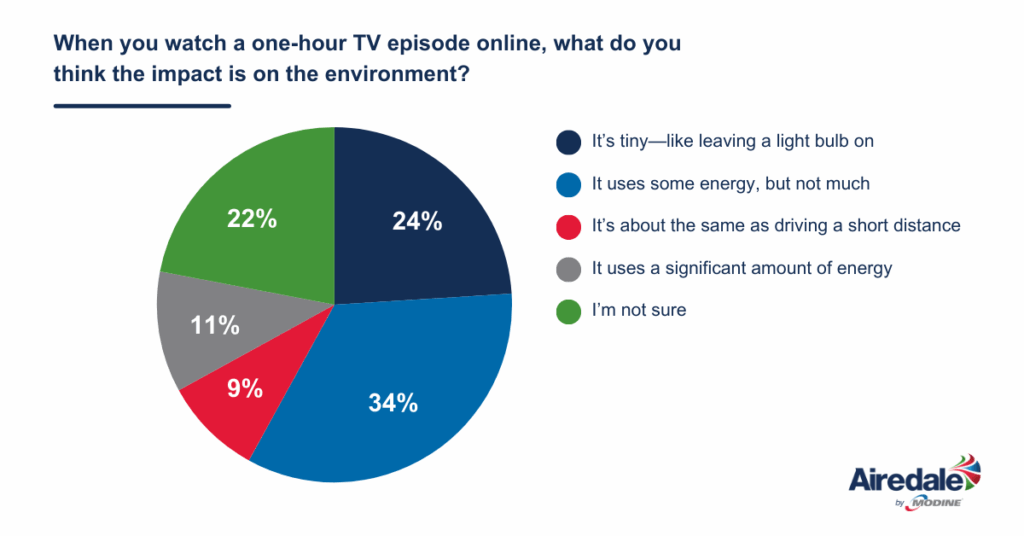
Taken together, these signals point to a model that underestimates scale, reinforces confusion, and externalizes responsibility, keeping the environmental cost remote and outspread. People care in general, but the hidden impact means it rarely shapes how they stream or scroll.
Design nudges beat self-control
When decisions are quick and the feed never stops, effortful self-restraint is a weak brake. Cues embedded in the experience are more noticeable in the moment, making them more likely to shape what people do than appeals to willpower.
67% say they would close or use less if shown a clear red carbon warning, and 59% say light friction—such as pop-ups, slower loads or price nudges—would curb bingeing. By contrast, manual trade-offs are uncommon: 56% say they have never lowered streaming quality to save energy.
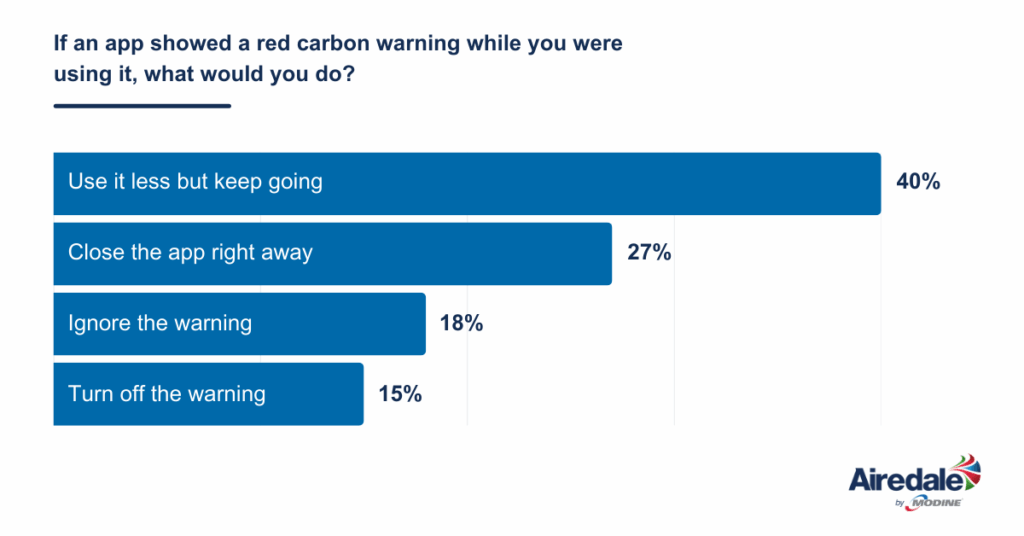
Taken together, these results indicate that immediate, context-specific signals intersect with digital guilt in a way that abstract intentions do not. Salient prompts register; voluntary downgrades and background pledges tend to recede.
Claims are fragile, and proof earns attention
Catch-all sustainability slogans meet growing skepticism in a context where the environmental cost of digital services is abstract and largely invisible. People look past broad promises and focus on whether the underlying infrastructure is actually cleaner and how that is shown in the product experience.
35% doubt “carbon-neutral” claims. At the same time, 63% want companies to advertise how eco-friendly their data centers are, and 53% say they would use or feel more positive about an app if its infrastructure ran on cleaner power.
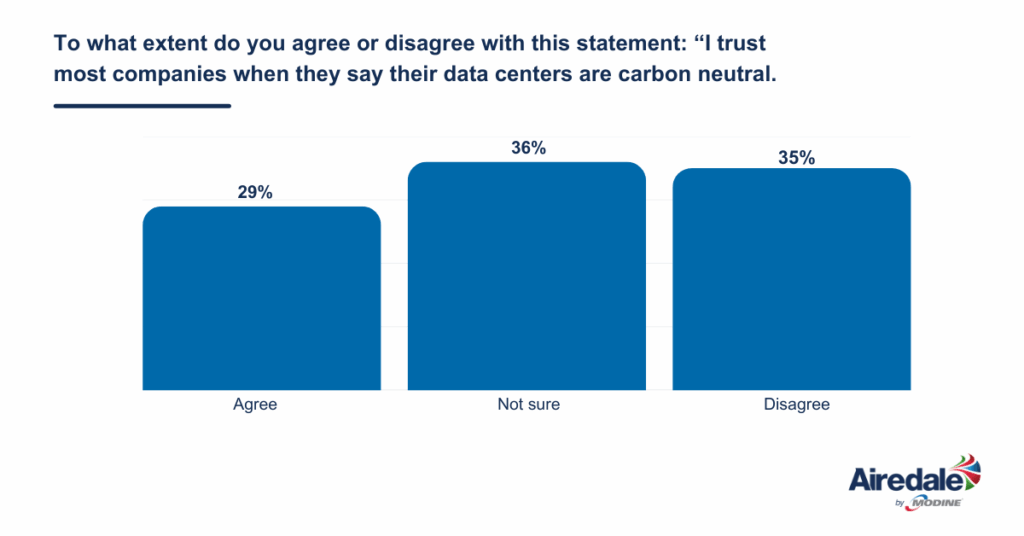
Taken together, the pattern points to credibility grounded in specificity and visibility: statements about overall neutrality carry less weight than clear signals about the underlying technology, its sourcing, and operational choices that reduce impact.
Responsibility is shifting upstream; social pressure is weak
People see the environmental cost of digital life as a system issue more than a personal one. Expectations concentrate on the organizations that run the infrastructure, while peer pressure and interpersonal judgments rarely shape everyday use.
68% say tech companies—or “all equally”—should lead emissions reductions. At the same time, social cues have little pull: 63% would brush off criticism or haven’t thought about it, and 75% report either never having considered avoiding content (50%) or not having felt that discomfort themselves (25%). Interest in what providers do upstream remains high, reflected elsewhere in calls for visible information about data center practices.
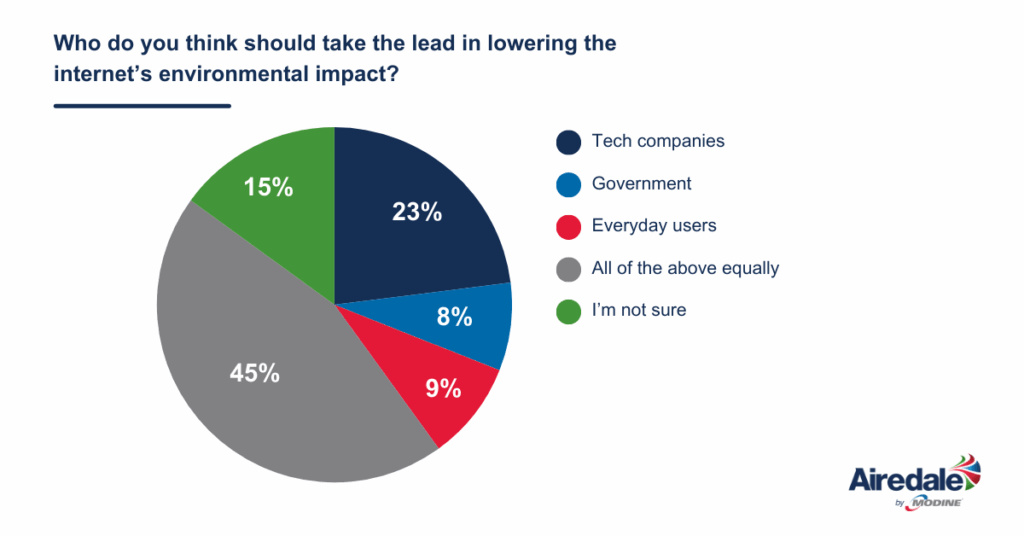
Taken together, the center of gravity for action sits with platforms and providers rather than one-to-one social dynamics. Guilt tends to be private, norms are scattered, and pressure among users is limited—leaving institutional choices more prevalent than interpersonal ones.
Conclusion: from digital guilt to visible progress
The evidence is clear. People care about the environment and recognize there is a footprint behind streaming, AI, and the cloud. Yet habits persist, the cost of the infrastructure remains out of sight, and broad claims struggle to earn trust. The result is a perception–action gap: concern is present, but it rarely steers everyday use.
A more productive path is emerging. Make performance improvements real in the data center and visible in the experience. For operators facing surging compute demand, climate-conscious cooling is a decisive lever: higher-efficiency air and liquid solutions, heat-reuse readiness, free-cooling strategies, low-GWP refrigerants and advanced controls can cut energy and water use while protecting uptime and rack density. These gains help data centers meet rising load without compromising sustainability, and they create credible metrics that product teams can communicate simply.
Airedale is built for this inflection point. Its portfolio is focused on reducing cooling energy at scale, optimizing for PUE and WUE, and instrumenting systems so improvements are measurable and auditable. That combination—efficient hardware, intelligent controls, and verifiable data—turns infrastructure upgrades into proof points that brands can bring to customers.
“Digital experiences win when the infrastructure behind them earns trust,” said said John Williams, Group Vice President – Americas DC, Airedale by Modine. “The conversation has moved beyond slogans. People want assurance that the systems powering their feeds and AI are efficient, resilient, and getting cleaner over time. Our role is to make that true and make it visible. By reducing the cooling footprint and giving operators clear, credible ways to show progress, we help expand capacity without expanding impact. That is how the industry turns digital guilt into confidence and secures the license to grow.”
Digital life is not slowing down. Providers that pair efficiency investments—especially in cooling—with transparent communication will be best placed to turn digital guilt into confidence, meeting the moment on performance and the climate in one move.





